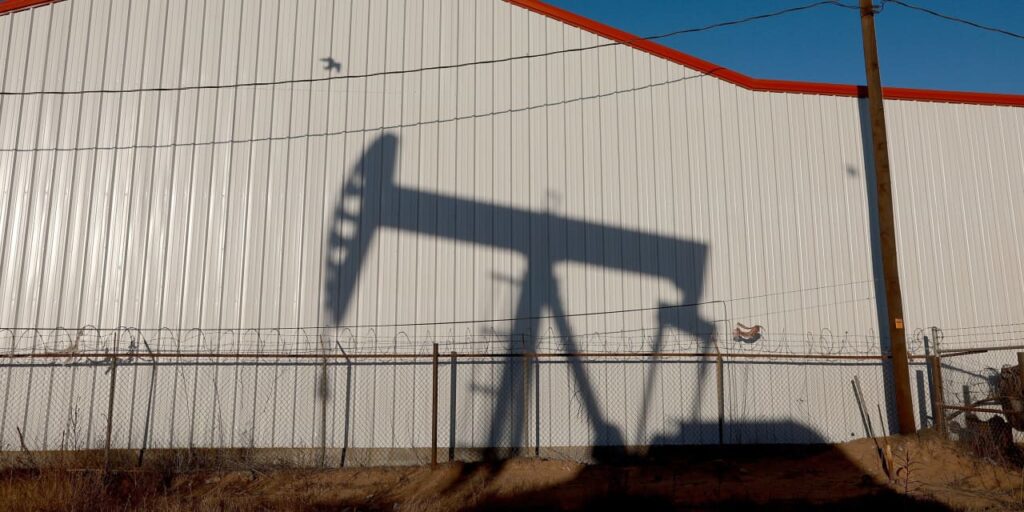Oil futures climbed Wednesday, with global benchmark Brent crude settling at its highest in more than three weeks, a day ahead of an expected decision by OPEC+ producers on oil output quotas.
Negotiations between the group of major oil producers have continued, with The Wall Street Journal reporting that OPEC+ is considering new oil output cuts and some news reports raising the possibility of another delay to a meeting that had already been postponed.
U.S. government data, meanwhile, revealed a sixth consecutive weekly rise in domestic crude supplies, while traders assessed storm disruptions to crude shipments on the Black Sea.
Price action
-
West Texas Intermediate crude for January delivery
CL00,
+1.52% CL.1,
+1.52% CLF24
rose $1.45, or 1.9%, to settle at $77.86 a barrel on the New York Mercantile Exchange, the highest front-month contract finish since Nov. 14, according to Dow Jones Market Data. -
January Brent crude
BRNF24,
the global benchmark, added $1.42, or 1.7%, at $83.10 a barrel on ICE Futures Europe, the highest settlement since Nov. 6. February Brent
BRN00,
+1.34% BRNG24,
the most actively traded contract, added $1.41, or 1.7%, to $82.33 a barrel. -
December gasoline
RBZ23
climbed 2.4% to $2.28 a gallon and December heating oil
HOZ23
declined by 0.6% to $2.89 a gallon. -
Natural gas for January delivery
NGF24
settled at $2.80 per million British thermal units, down 1.2%.
All eyes on OPEC+
The main market mover for oil will be the meeting of the Organization of the Petroleum Exporting Countries and member allies, said Tariq Zahir, managing member at Tyche Capital Advisors. He said he expects the group to extend, and perhaps even increase, production cuts at the meeting scheduled for Thursday.
“This is why we feel the market got a little stronger” on Tuesday and why oil prices saw a follow through on Wednesday, he said.
The OPEC+ meeting was delayed by a few days to “get an agreement with all the countries involved,” said Zahir. “With Saudi the 500-pound gorilla at the table, they are looking for other OPEC members to comply and even increase production cuts.”
OPEC+ may be considering new oil production cuts of as much as 1 million barrels a day, delegates said Wednesday, according to The Wall Street Journal.
News reports have indicated, however, that talks between OPEC+ members remain difficult, casting uncertainty around an online meeting Thursday. The meeting had previously been set for Nov. 26 but was postponed.
Output cuts by OPEC+ — particularly an added reduction of 1 million barrels a day by Saudi Arabia, which was implemented in July and extended through the end of this year — were credited with lifting crude prices over the summer.
OPEC+’s power “derives from its ability to act as a single bloc, increasing or decreasing production in unison to manage prices, so we would expect the group to reach an agreement to extend (if not outright expand) its recent production cuts to support prices later this week or the next,” Matthew Weller, global head of research for Forex.com and City Index, said in a note.
“That said, the tail risks of a failure to reach an agreement is on the rise, presenting an underappreciated potential for even more volatility in the oil market,” he said.
Meanwhile, Russia’s transportation ministry said Wednesday that Black Sea weather conditions remained unfavorable for shipping and that restrictions would remain in place, Reuters reported. A severe storm in the region has disrupted exports of up to 2 million barrels a day from Kazakhstan, the report said.
Supply data
On Wednesday, the Energy Information Administration reported that U.S. crude supplies rose for a sixth consecutive week, with petroleum product stocks also on the rise.
U.S. commercial crude inventories rose by 1.6 million barrels for the week ended Nov. 24.
On average, analysts polled by S&P Global Commodity Insights expected the report to show a decline of 700,000 barrels. The American Petroleum Institute late Tuesday reported crude inventories fell by 817,000 barrels last week, according to a source citing the data.
The EIA report showed supply increases of 1.8 million barrels for gasoline and 5.2 million barrels for distillates. The forecast called for a gasoline supply rise of 200,000 barrels and a decline of 100,000 barrels for distillates.
Crude stocks at the Cushing, Okla., Nymex delivery hub climbed by 1.8 million barrels last week, the EIA said.
Read the full article here



